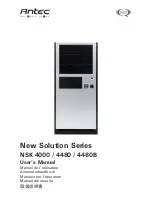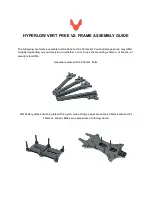
Installation
SS-SVX004C-EN
11
grade refrigerant copper piping. Dry nitrogen should be
flowing through the tubing while soldering at a rate of not
less than 1-2 CFM. Be careful not to allow solder/piping
debris to get inside refrigerant lines.
When brazing copper-to-copper connections (piping
liquid line or suction line), use a phosphorus copper
brazing alloy with 15% silver. General purpose silver
brazing alloy with 45% silver is to be used for copper-to-
brass or copper-to steel.
Refrigerant Pipe Sizing
Refrigerant lines for split systems must be sized according
to the piping distance between the evaporator and the
condensing unit. Each valve, fitting and bend in the
refrigerant line must be considered in this calculation.
Refer to the following chart for standard equivalent
lengths, in feet, of straight pipe.
The general guidelines in below table may be used to
assist in determining the size of the refrigerant lines
between the evaporator section and the remote
condensing unit.
Table 1.
Standard equivalent ft of straight pipe
Equivalent Length (ft) of Straight Pipe
OD (in.)
Line Size
Globe
Valve
Angle
Valve
90º
Elbow
45º
Elbow
Tee
Line
Tee
Branch
1/2
9.0
5.0
0.9
0.4
0.6
2.0
5/8
12.0
6.0
1.0
0.5
0.8
2.5
7/8
15.0
8.0
1.5
0.7
1.0
3.5
1-1/8
22.0
12.0
1.8
0.9
1.5
4.5
1-3/8
28.0
15.0
2.4
1.2
1.8
6.0
1-5/8
35.0
17.0
2.8
1.4
2.0
7.0
2-1/8
45.0
22.0
3.9
1.8
3.0
10.0
2-5/8
51.0
26.0
4.6
2.2
3.5
12.0
3-1/8
65.0
34.0
5.5
2.7
4.5
15.0
3-5/8
80.0
40.0
6.5
3.0
5.0
17.0
Refer to the tables on the following pages for
recommended suction and liquid line pipe sizes for the
A/C system that is installed. Things to consider when
sizing refrigerant piping are the varying BTU capacities of
indoor evaporators and the equivalent length of pipe
needed between the remote condensing unit and the
evaporator. If the pressure drop is too high, the capacity of
the compressor decreases and the power required
increases. An excessive refrigerant charge will be used if
the volume of the piping is too large.
Note:
The size of the equipment pipe connections does
not indicate the size of the refrigerant lines to be
used. In cases where the pipe size doesn’t match
the size of the connection, reducing fittings should
be used to transition between the connection and
the pipe.
Suction Line
If the condensing unit is installed above the evaporator,
the suction line should include a shallow P-trap at the
lowest point in the piping (see
in the suction line should be above the condensing unit
coil. Additionally, shallow P-traps must be included in the
suction line for every 20 ft of vertical rise. All horizontal
refrigerant lines should be pitched in the direction of flow
at least ¼ inch for every 10 ft.
Note:
All suction lines should be insulated to prevent
condensation from forming.
Refer to the below figure that shows a typical piping
diagram for when the condensing unit is located at a
higher level than the evaporator. In this situation it’s
important to size the suction line properly. If the suction
line is sized correctly for full load operation, the velocity of
the gas may be too low during minimum load conditions
to carry the refrigerant oil up the suction line to the
compressor. Decreasing the size of the suction line will
increase refrigerant velocity however, it will also restrict
the flow of refrigerant at full load conditions creating an
excessive refrigerant pressure drop. Ensure the suction
line is sized to maintain a minimum velocity of 700 fpm of
refrigerant in horizontal lines and 1500 fpm of refrigerant
in vertical lines. This will ensure the refrigerant flows at a
velocity high enough for the refrigerant vapor to carry the
oil with it to the compressor.
Figure 4.
Piping installation
Pitch in direction of refrigerant flow
Trap in bottom of column
with minimum trap depth possible
Trap every 20 ft (6100 mm) with minimum trap
depth possible
Pitch minimum 1/4 in. for every 10 ft (5 mm/2400 mm)
of run pitch in direction of refrigerant flow
(Suction and Liquid lines)
Remote
Condensing Unit
Suction Line
Evaporator or
Air Handler
Liquid Line












































